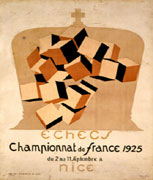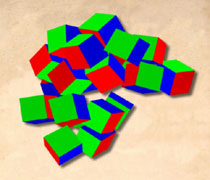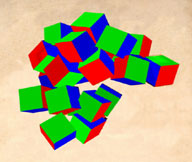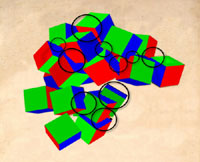Did Duchamp simply use a photograph of "tossed cubes" to create his 1925 Chess Poster? by Rhonda Roland Shearer and Robert Slawinski
|
|||||||||||||||||||||||||||||||||||||||||||||
|
Introduction
Duchamp claimed that he created his 1925 Poster for the Third French Chess Championship from a photograph (Fig. 1). Schwarz writes in his Catalogue Raisonné of Duchamp's works (708):
If Duchamp's positioning of the cubes in his 1925 Chess Poster came "readymade" from a photograph that he took of tumbling blocks in a net, then we should be able to take various camera lenses used in 1925, place cubes in the positions depicted, and be able to generate a "photograph" matching Duchamp's poster. We tried this experiment using computer modeling and animation software, and made a surprising discovery. In order to co-exist simultaneously in the spatial position that Duchamp depicts in his poster, the individual cubes that Duchamp photographed would have to have interpenetrating surfaces, edges and vertices--a completely different scenario and physical reality from Duchamp's story of photographing free falling cubes.
Step 1 Look at the Poster itself
Examine Figure
2 and more specifically cube 2 or cube 11. The shapes of
these cubes, as well as others, appear to be anomalous. In other words,
these objects are not symmetrical cubes with six square sides, at right
angles to each other and depicted with edges that follow all the rules
of perspective, as would be captured by a photographic lens. Cube 2's
black top square appears smaller than the vertical length of its cream
colored square, instead of the same size and symmetry as in our expectation
and prior experience of cubes drawn in perspective. We note the same
situation for cube 16. The pinkish brown cube's vertical square (on
the right side) seems taller than wide, when carefully compared to the
shape of the top black square. The more you study these individual
cubes by observation alone, even without test or measure, the more maddening
the subtle feeling of contradiction becomes--from "yeah they're
cubes" to the eye, to "what the hell, something is wrong with
these cube shapes when I compare the squares to each other more carefully"
in the mind. We noted the similarity between the shifting sense from distortion to regularity (or non-cubes to cubes) in Duchamp's Chess Poster, and a class of optical illusions called "impossible figures" and named by Penrose and Penrose in the 1950s (R. R. Shearer, "Marcel Duchamp's Impossible Bed and Other "Not" Readymade Objects," Part I and Part II)(3) Impossible Figures, such as "The Impossible Tri-Bar" discovered by Oscar Reutersvärd in 1934, (See figure 3), characteristically capture us in a cycle of acceptance based on familiar visual cues, followed by a looping back to rejection resulting from nagging contradictory information. Then, after further mental examination, we again visually accept, but then again reject, what we see, ad infinitum. Nigel Rogers, in his book Incredible Optical Illusions, writes about the tri-bar figure: "All those sides appear to be perpendicular to each other and to form a neat, closed triangle. But when you add up the sums of their three right-angled corners, you reach a total of 270 degrees--that is 90 degrees more than is mathematically possible" (62).(4) In other words,
Reutersvärd squeezed into his representation (and into triangles themselves
which, in Euclidean space, are defined as limited to 180 degrees) more
degrees of freedom than would be allowed by real 3D space. The paradoxical
positionings in Reutersvärd's impossible cube drawings (1934, Fig.
4; 1934 Fig. 5; 1940 Fig.
6) remind one of Duchamp's 1925 chess poster cubes. In fig.
5, as you look at the three cubes--you must ask how the two lower cubes
can be equal in height at the bottom and of such different heights at
the top, yet still be the same size all at the same time? Since Reutersvärd
has been credited as the first discoverer and developer of Impossible
Objects (before Escher in the 1950s), the chess poster indicates that
Duchamp himself was actually first, having predated Reutersvärd by at
least nine years. (Shearer previously argued that Duchamp's impossible
bed in the Apolinére Enameled work of 1916-17, indicates
that Duchamp already understood the concept of impossible objects, and
the optical illusions based upon them, eighteen years before Reutersvärd's
discovery in 1934 (see Shearer,
Part I and Part II.)
Step 2 Place blocks in position Using SoftImage
3D modeling and animation software as a tool, we placed 21 red/blue/green
blocks, following the pattern of the falling cubes in Duchamp's poster
(see Fig. 7A, a video computer animation
of our 3D model of red/blue/green shaded cubes, and Fig.
7B an illustration of our 3D model cubes in the places determined
by Duchamp chess poster blocks).
Step 3 Note and then characterize the differences in ten locationsThe striking difference
in relationships among cubes that we immediately saw when we tried to
arrange our red/blue/green blocks into Duchamp's beige/pinkish brown/black
cubes, pattern shows the necessity for imbedding the cubes into each
other. With this new arrangement, the odd distortions in the original
poster disappeared (see Fig. 8A &
Fig.8B, a video animation that circles
ten embedded locations and then magnifies the circled area, both in
the original poster, and in our 3D model arrangement for making comparisons,
and a still image that can be enlarged for study.)
»Next
Page 1 2
Notes
Figs.
1,
2, 4, 7A |
|||||||||||||||||||||||||||||||||||||||||||||






















